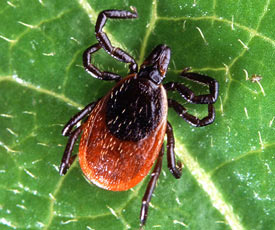NCC: The truth about ticks

Adult deer tick (Photo by Scott Bauer/Wikimedia Commons)
Ticks seem to be everywhere these days. They’re on the news, on your social media feed and maybe even on your skin. People, especially those in southern Canada, are dealing with blacklegged ticks (also called deer ticks) with increasing frequency.
Found in southwestern and eastern Ontario, as well as parts of British Columbia, Manitoba, Quebec and Nova Scotia, blacklegged ticks can cause Lyme disease, an infectious disease spread by tick bites.
In 2019, there were 2,636 cases of Lyme disease reported to the Public Health Agency of Canada; an increase from 144 in 2009. Lyme disease isn’t the only harmful bacteria these parasitic arachnids can carry. Borrelia miyamotoi, which causes similar symptoms to Lyme disease, and the Powassan (POW) virus are also causes for concern.

Ticks (Photo by Diana Bizecki Robson)
The good news is that you can learn to protect yourself from tick bites. All you need are the facts, and you can continue to enjoy the outdoors — tick-free. Here are a few questions that I often get about tick safety:
1. Are ticks common or rare?
It’s difficult to say, as they often have patchy distribution — sometimes you may find many, other times you may go weeks or months without seeing any. If you are bushwhacking in places where there are deer, then your chances of seeing them increase.
2. How dangerous are ticks?
Ticks themselves are not dangerous, but they can carry various bacterial diseases that are harmful to humans.
3. Can I use DEET or mosquito spray to keep them away?
DEET is somewhat effective at repelling ticks. It is best to also wear long sleeves and pants, and to keep loose clothing tucked in to provide a physical barrier.
4. Can ticks get carried into my vehicle? Can they get caught in my tent and brought home with me?
To both of the above — absolutely! If a tick hitches a ride on you, it will often wander around on clothing and skin for some time, looking for the perfect place to have supper. During this time, it may get brushed off, or wander onto your vehicle’s upholstery or onto something in your tent. Ticks can even survive a cold laundry wash and can end up anywhere in your home. The best way to avoid these scenarios is by brushing off all of your gear before you head home. This is a good way to help stop the spread of plants and insects in general and is a good practice to make a habit of.
5. I kayak and canoe in rivers and lakes. Can ticks get inside my boat when it’s on the shore?
Look over your vessel before you jump in it. Artificial materials, such as plastics and metals, can be inhospitable environments for a tick. The risk is there, but is likely to be relatively low. Just make sure you check yourself over at the end of your day.
6. How do I effectively check myself for ticks?
The best way is to remove all your clothing and look for ticks. You can run your hands over your skin to find any that may be embedded. Some people find ticks tickly when they are walking around on their skin, or itchy when they are embedded, so that can make them easier to find, but don’t rely on feeling them. Look carefully!
7. Are there ticks in my garden, local neighbourhood park or are they just in really “wild” areas in the countryside?
It is quite possible that they could be in any of those spots, as any area with plants and mammals may harbour ticks. They are a natural part of our wild ecosystems.
8. What should I wear to help avoid picking up ticks or getting bitten by them? Are there any colours or fabrics they don’t like?
Wear long sleeves and pants, and tuck your pants into your socks and your shirt into your waistband. Wearing light-coloured clothing makes it easier for you to see them.
9. My local pharmacy sells tick removers. Are these helpful in removing an embedded tick? Should I still go to my doctor or local emergency if I suspect a tick bite?
There are several kits available to help you remove ticks and they can be very effective. The sooner you remove an embedded tick, the less risk you have of contracting a disease. However, if you do have an embedded tick, it’s always a good idea to visit your doctor immediately and seek a course of antibiotics, just to be sure. If the tick is wandering around on you and looking for somewhere to bite, then simply brush it off and check yourself and your gear thoroughly for others. If the tick has not bitten you, your chances of contracting a tick-borne disease are negligible.
10. How quickly should I go to my doctor if I suspect a tick bite?
As soon as you possibly can, preferably that day or the next. The sooner you can get treatment, the more effective it is.




